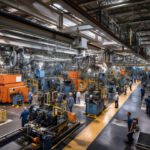Virtual reality and augmented reality are two technologies that are changing the maintenance industry. Maintenance professionals use virtual reality training to learn and practice skills before going on-site. Once on the job, technicians use augmented reality to help them perform tasks.
Virtual Reality Training
Virtual reality uses computer technology to create a simulated environment. Users interact with the virtual environment through specialized equipment such as headsets and hand-held sensors. You may be familiar with the use of virtual reality in video games that can be played using headsets available from companies like Oculus, HTC, and Samsung. These headsets let users feel like they are actually in the simulated environment, which can be anything from the driver’s seat of a race car to the surface of an alien planet. Though not as much fun as zipping across the (virtual) finish line, virtual reality is also being used in maintenance training to help technicians develop skills.
Wearing virtual reality headsets, maintenance technicians can learn new skills quickly. Flexibility in scheduling and location mean technicians don’t have to spend time waiting for physical equipment to be available or offline in order to practice tasks, reducing overall training time. Minimizing training time is important for the many companies experiencing talent shortages as older workers retire and take years of expertise with them. Younger workers are available, but many lack the skills necessary to fill open maintenance positions. In a virtual environment, technicians can practice skills as many times as needed until they are mastered. Technicians with virtual reality training are familiar with equipment and procedures before they arrive on the job site and commit fewer errors once on the job.
Inside a virtual environment, technicians can safely repeat and learn dangerous procedures without personal risk. Virtual reality training also allows technicians to perfect tasks before they enter a high-risk environment, such as a nuclear plant. Training in a virtual environment protects equipment as well. Technicians can practice new skills and techniques repeatedly without risking damage to equipment.
Augmented Reality Resources
Augmented reality technology overlays computer-generated information on the user’s view of the real world as seen through a device such as a smartphone. Television sports broadcasts use augmented reality to overlay information such as the first down line in an NFL game on your screen. Augmented reality is also seen in vehicle heads-up displays and the photo filters available on social media apps. Augmented reality does not require special equipment and is available on common devices such as smartphones and tablets, as well as hands-free devices like Google Glass. The accessibility and portability of augmented reality help maintenance teams while out performing service activities.
With augmented reality, technicians can scan a QR code and quickly access important information about a piece of equipment. Technicians can use a smart phone, tablet, or laptop to remotely access documents like manuals, plans, and part lists. Augmented reality also delivers information by superimposing it over the real world view as seen through a smart device display. For example, a technician can use their smartphone camera to view a piece of equipment and see a 3D diagram of the item overlaid on the real-time image on their phone screen. Wearing Google Glass or a similar headset, a technician can look at a piece of equipment and view maintenance instructions “right in front of their very eyes,” leaving their hands free to perform the task.
Technicians can use augmented reality to collect data from equipment sensors. Sensors that monitor equipment conditions such as temperature, humidity, and vibration are used to help develop predictive maintenance plans, reducing unnecessary reactive and preventive maintenance. With augmented reality, on-site technicians can also get immediate access to current or historic equipment data to determine maintenance needs, diagnose issues, and monitor the success of their maintenance efforts.
Augmented reality allows users to consult with remote experts in real time. These experts may be hundreds or even thousands of miles away, but they can see a live view of the work site and deliver instant feedback and instruction. Remote experts can give live verbal guidance and overlay visual information on the technician’s device screen. Remote experts can provide a variety of visual information to technicians, including labels identifying parts and animated instructions showing procedural steps. The ability to access expert knowledge helps technicians reduce errors and perfect skills on the job. Using remote viewing, experts can visually evaluate equipment and direct technicians through appropriate procedures without having to travel to the site. With fewer errors and no travel time for experts, maintenance is performed promptly, with a minimum of equipment downtime. Some companies are using augmented reality to offer similar services to end users. Customers can connect with support teams through augmented reality for help with troubleshooting and repairs. Support staff can see a live view from the customer and provide real-time instruction and guidance.








